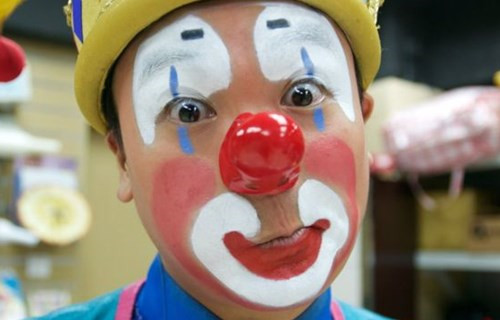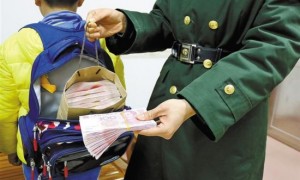导读:那些在我们的生活中扮演欢乐角色的小丑,脱下戏服并不总是笑逐颜开。对亚洲小丑而言,他们的收入相当可观,吸引了一批批后继者。但对欧美小丑来说,日子就没那么好过了。

Dressed in a patchwork of bright colours, Ken Ken the Clown fashions a flower out of yellow and pink balloons, and smiles widely.
身着亮色拼缝物,小丑肯肯化身一团黄粉气球,笑颜尽绽。
One of the first professional clowns in Hong Kong, the 35-year-old says that for the past 15 years he has been pursuing what he calls a "positive" career that "makes people happy".
在过去的15年里,35岁的肯肯是香港首批职业小丑之一,他一直在追寻自己所谓的“积极”职业,“让人们开心”。
Often fully booked, Ken Ken can earn as much as HK$550,000 ($71,000; 57,000 pounds) per year. And such is the continuing popularity of hiring a clown in Hong Kong for kids’ parties that he is far from alone.
通常情况下,他的演出座无虚席,一年收入约为550000港币(71000美元,57000英镑)。这是由于香港在孩子聚会上一直流行雇佣小丑,肯肯的情况并不是个例。
While he cut a lone figure back in 2001, Ken Ken says that today there are as many as 50 other professional clowns in the special administrative region, and that the number is rising fast.
2001年时,他不再孤单,肯肯说,如今的特别行政区另有50名专业小丑,并且数量增长迅速。
In fact, such is the current demand for clowns in Hong Kong that employment agencies are organising classes to train up people.
事实上,这是由于香港目前的小丑需求,使得雇人机构正在组织培训课程。
One such agency is Grace Training and Development Centre. Enya Hui, one of its employment officers, says that clowning is now a "viable career path".
其中的一个机构是格蕾丝培训和发展中心。中心雇员之一Enya Hui说,如今的小丑拥有“多元化发展路线”。
The current popularity of clowns in Hong Kong is in marked contrast to the woes faced by the entertainers in the US and Europe, who this year have had to endure the so-called "creepy clown craze".
目前香港小丑的流行与美国和欧洲艺人所面对的困境形成鲜明对比。今年,美国和欧洲的艺人不得不忍受所谓的“令人毛骨悚然的小丑热”。
This unlikely phenomenon on both sides of the Atlantic saw people dressing up as scary clowns to terrify children and adults alike. It led to some schools going as far as even banning children from talking about the craze.
大西洋两岸都发生了不太可能的现象,人们穿着的像恐怖小丑一般,吓唬孩子和大人。这导致一些学校甚至禁止儿童讨论小丑热。
Against such a backdrop it is not surprising that clowns in the US and Europe have recently found bookings harder to come by - mums and dads are not likely to hire a clown for their child’s birthday party if their little one is now scared of them.
在这种背景下,美国和欧洲的小丑最近很难被预定就不令人惊讶了——爸爸和妈妈不太可能在孩子的生日聚会上雇佣小丑,如果他们的小孩如今害怕小丑。
What is less well known is that the clowning industry has been in long-term decline in its established markets, with the World Clown Association saying that membership numbers have fallen by almost a third over the past 10 years, from about 3,500 to 2,500.
但是不被鲜为人知的是,在现有的市场上,小丑产业长时期处于衰落状态。世界小丑协会称,在过去的十年里,协会成员减少了将近三分之一,从3500人下降到2500人。
So why are clowns struggling in the US and Europe, but booming in Hong Kong and other Asian countries, such as India?
那么,为什么美国和欧洲的小丑处于水深火热之中,香港和譬如印度的其他亚洲国家却欣欣向荣呢?
When not performing as a clown Ken Ken’s real name is Kenneth Ng. Describing his clown persona as "a happy and hyperactive five-year-old", Mr Ng says that it took him 10 years to develop the character.
在不表演的时候,肯肯的真实姓名是Kenneth Ng。Ng先生将自己的小丑个性描述为:一个快乐并且活跃的五岁孩子”,他花了十年的时间发展出了这种个性。
While he always plays the same role, he says that "every performance is different".
尽管他总是扮演同样的角色,但是他说,“每场表演都是不同的”。
With up to 100 performances a year, plus income from training other clowns at a weekly class, Mr Ng earns enough money from being a clown for it to be his only profession.
每年百场演出外加每周训练其他小丑的收入,Ng先生将小丑作为唯一的职业挣足了钱。
This is in marked contrast to most clowns in the US and Europe, who usually need another job to supplement their income.
这和欧洲和美国的绝大多数小丑形成了鲜明对比,他们通常需要另外一份工作来补贴自己的收入。
Julie Varholdt, 52, a fourth-generation clown from Phoenix, Arizona, says that a typical clown in the US earns just $14,000 a year. This is five times less than Mr Ng, so one reason for the growing popularity of clowning in Hong Kong but decline in the US is inevitably financial.
来自凤凰城的52岁的第四代小丑朱莉说,美国的典型小丑一年挣14000美元。这比Ng先生的收入少五倍,所以造成香港小丑越来越流行和美国小丑衰落的一个不可避免的原因就是经济。
Another difference between clowning in Asia and that in the US and Europe is a significant age gap.
亚洲和欧美小丑的另一个不同之处是显著的年龄差。
"You don’t find a lot of young clowns in the West," says Mr D’Souza. The average age of clowns in Asia is between 25 and 30, whereas in the West, the average age is over 50.
弗兰克先生说:“西方没有很多年轻小丑,亚洲小丑的平均年龄是25岁到30岁,然而在西方,平均年龄超过50。”
In the West they don’t think of clowning as a lucrative career... but in Asia people are really looking at it as an alternative to an office or factory job."
“在西方,人们并不觉得小丑是个有利可图的职业,但是在亚洲,人们真的把它看作办公室或者工厂工作外的另一种选择。”
As discussed, the problem for most clowns in the West is that it doesn’t pay a great deal.
如上所讨论,对西方绝大多数小丑来说,他们赚的不多。
To attract more clowns in the US and Europe there will need to be an increase in popularity, which would raise demand and therefore earnings.
为了吸引更多的欧美小丑,需要提高小丑流行度,这会增加需求和收入。







